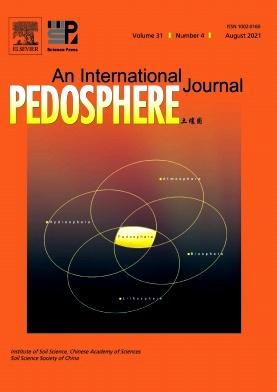Effects of plasticizer on removal of antibiotics and antibiotic resistance genes from agricultural soils via soil microbial fuel cells
IF 7.3
2区 农林科学
Q1 SOIL SCIENCE
引用次数: 0
Abstract
Soil microbial fuel cells (MFCs), a novel ecosystem technology, have recently been intensively studied for antibiotic-polluted soils. However, actual agricultural soils are always contaminated by mixed pollutants, especially plasticizers from extensively used agricultural plastic films. The aim of this study was to investigate the effects of di-2-ethylhexyl phthalate (DEHP), a representative plasticizer in soil, on the removal of sulfadiazine (SDZ), a frequently detected antibiotic in natural environments, and antibiotic resistance genes (ARGs) and microbial community in soil MFCs. Soil MFCs maintained a good antibiotic removal ability even under the influence of residual DEHP and achieved a higher removal performance at higher DEHP concentrations due to enhanced power generation. Specifically, a higher DEHP concentration had a favorable effect on antibiotic removal in soil MFCs, with the SDZ concentration decreased in both the upper and lower layers (from 4.867 ± 0.221 to 0.268 ± 0.021 and 0.293 ± 0.047 mg kg-1, respectively) of polluted soils. Moreover, a high DEHP concentration significantly promoted the abundance of bacteria associated with electricity generation compared with a lower DEHP concentration, resulting in the promotion of extracellular electron transfer and enhancing SDZ degradation. The increased ARG abundance may be caused by the enrichment of ARG potential hosts brought about by high DEHP concentration, likely due to the increased conjugative transfer frequencies of plasmid RP4 by decreasing cell membrane permeability and increasing reactive oxygen species content. The results revealed the ecological risk of residual DEHP in soil that promotes ARG transmission in soil MFCs, although it has the potential to reduce SDZ toxicity through horizontal gene transfer. We also highlight concerns regarding the management of antibiotics and plasticizers in soil. The negative effects of plasticizers on antibiotic removal should be carefully evaluated when using soil MFCs for the in-situ remediation of antibiotic-contaminated soil.
增塑剂对土壤微生物燃料电池去除农业土壤中抗生素和抗生素抗性基因的影响
土壤微生物燃料电池(MFCs)是一种新型的生态系统技术,近年来在抗生素污染土壤中得到了广泛的研究。然而,实际的农业土壤经常受到混合污染物的污染,特别是广泛使用的农用塑料薄膜中的增塑剂。本研究旨在探讨土壤中具有代表性的增塑剂邻苯二甲酸二乙己酯(DEHP)对自然环境中常见的抗生素磺胺嘧啶(SDZ)的去除以及土壤mfc中抗生素抗性基因(ARGs)和微生物群落的影响。即使在残留DEHP的影响下,土壤mfc也保持了良好的抗生素去除能力,并且由于发电量的增强,在更高DEHP浓度下,土壤mfc的去除性能也更高。其中,较高的DEHP浓度对土壤mfc中抗生素的去除效果较好,污染土壤的上层和下层SDZ浓度均下降(分别从4.867±0.221 mg kg-1降至0.268±0.021 mg kg-1和0.293±0.047 mg kg-1)。此外,与较低DEHP浓度相比,高DEHP浓度显著促进了与发电相关的细菌丰度,从而促进了细胞外电子转移,增强了SDZ的降解。ARG丰度的增加可能是由于高DEHP浓度导致ARG潜在宿主的富集,可能是由于质粒RP4通过降低细胞膜通透性和增加活性氧含量而增加了其共轭转移频率。结果表明,土壤中残留DEHP的生态风险促进了ARG在土壤mfc中的传播,尽管它具有通过水平基因转移降低SDZ毒性的潜力。我们还强调对土壤中抗生素和增塑剂管理的关注。在使用土壤mfc对抗生素污染土壤进行原位修复时,应仔细评估增塑剂对抗生素去除的负面影响。
本文章由计算机程序翻译,如有差异,请以英文原文为准。
求助全文
约1分钟内获得全文
求助全文
来源期刊

Pedosphere
环境科学-土壤科学
CiteScore
11.70
自引率
1.80%
发文量
147
审稿时长
5.0 months
期刊介绍:
PEDOSPHERE—a peer-reviewed international journal published bimonthly in English—welcomes submissions from scientists around the world under a broad scope of topics relevant to timely, high quality original research findings, especially up-to-date achievements and advances in the entire field of soil science studies dealing with environmental science, ecology, agriculture, bioscience, geoscience, forestry, etc. It publishes mainly original research articles as well as some reviews, mini reviews, short communications and special issues.
文献相关原料
公司名称
产品信息
阿拉丁
DEHP
 求助内容:
求助内容: 应助结果提醒方式:
应助结果提醒方式:


